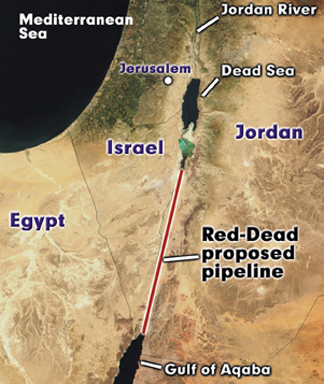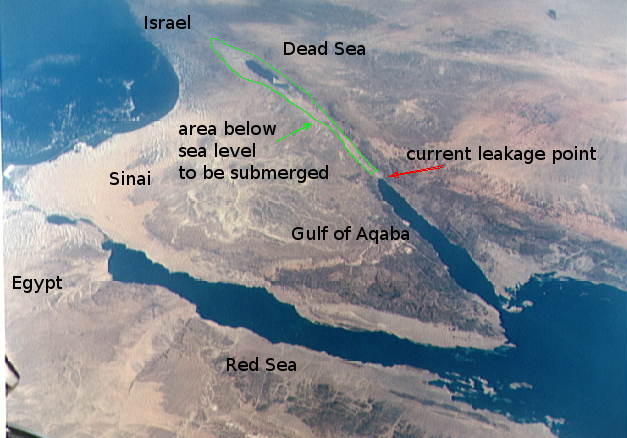News Notes Water and policy
Pipeline proposal promises new life for Dead Sea
More than 400 meters below sea level lie the calm waters of the Dead Sea. The saltiest major water body on Earth, the Dead Sea stands between Israel and Jordan and marks an area historically rich and scientifically significant. Its shores are the lowest point of dry land on Earth, and keep getting lower — now shrinking about 1 meter each year. In this region plagued by severe water shortages, scientists and politicians are now trying to come together in a massive effort that would move water from the Red Sea to the Dead Sea.
At the recent World Summit on Sustainable Development in Johannesburg, Israeli and Jordanian officials announced plans to build an $800-million pipeline between the two water bodies — hoping both to boost the receding water level and to desalinate the water for distribution to parched Jordan. Called the “Peace Conduit,” the pipeline will stretch about 320 kilometers north from the Gulf of Aqaba.
Israel and Jordan plan to build an $800-million pipeline between the Red Sea and the Dead Sea. As shown here, the pipeline will stretch 320 kilometers north from the Gulf of Aqaba. The project’s goal is to replenish the receding Dead Sea and to desalinate water to distribute to Jordan. The background true-color satellite image is from NASA/GSFC by Jacques Descloitres of the MODIS Land Rapid Response Team. Image by Mark Shaver.
“In principle, the creation of this pipeline is seductively appealing. It will allow the generation of large amounts of energy, which can be used in desalination, and at the same time it will allow the restoration of the hydrological balance in the Dead Sea,” says Nizar Abu-Jaber, an associate professor of geochemistry at Yarmouk University in Jordan. But the “Red-Dead” pipeline, already decades in the making, will take several years to complete, due in part to lingering scientific questions about how the project may change the Dead Sea dynamics, he says.
“The Mediterranean was the original concept, an idea lying around from 20 to 30 years ago,” says Gerry Friedman, a distinguished professor of geology at Brooklyn College and the Graduate Center of the City University of New York. However, this “Med-Dead” pipeline idea has lost some steam in the political realm over the last decade, and researchers are now largely focusing on the Red-Dead project that has been in consideration since Jordan and Israel signed a peace treaty in 1994. Friedman says the World Summit announce-ment was a way to “test the waters” for this relatively new idea to help the Dead Sea.
The Dead Sea is a terminal lake: water leaves only through evaporation. Water has historically come in mainly from the Jordan River, which flows south into the Dead Sea. “Because of the consumption of freshwater in the drainage basin, very little water reaches the Dead Sea today,” says Ittai Gavrieli, head of the department of geochemistry and environmental geology at the Geological Survey of Israel.
The Jordan River brings in only about 10 percent of what it used to bring in, he explains, because of the damming and diverting of the river itself and its sources by the Israelis and the Jordanians, as well as their Syrian neighbors to the north. “All together, the Jordan River probably brought in more than 1,000 million cubic meters [historically] and today it’s down to about 150,” he says. Also contributing to the water level’s recession is the potash industry that evaporates Dead Sea water for industrial minerals. “Dead Sea brine is pumped to the industrial evaporation ponds in the now-dry Southern Basin of the Dead Sea and flows back as end brine. In this process, they lose about 50 percent of the volume that they pump in,” Gavrieli says.
Despite these problems, the Dead Sea will not die, Gavrieli says. “Without the pipeline, the Dead Sea level will continue to drop; but the lake cannot die out,” he says. In work he and colleagues published in Geology (August, 1998), they report that in 200 to 400 years, the Dead Sea will stabilize at around 100 meters lower than it is today.
Still, this rapid depletion of water in the Dead Sea is causing problems regionally — pushing the shorelines farther and farther away from previously developed areas and, more seriously, creating sinkholes, particularly along the western shore. As the Dead Sea recedes, freshwater can move through layers of subsurface salt, replacing the saltwater and dissolving the underground layers. “With the salts gone, the ground caves in. They sort of look like bomb craters,” says Clifford Voss, a research hydrologist with the U.S. Geological Survey, who has visited the Dead Sea. These sinkholes, he says, are creating major infrastructure problems in the area.
In addition to replenishing the shrinking Dead Sea, the Red-Dead pipeline will meet another urgent need for the region: freshwater. The Red-Dead pipeline would make use of the 400-meter elevation difference between the seas to generate power to desalinate some or all of the water pumped from the Red Sea. “The reject brine, concentrated seawater after desalinization, will be diverted to the Dead Sea and the produced freshwater pumped mainly to Jordan and some to Israel and the Palestinian Authority,” Gavrieli explains.
|






